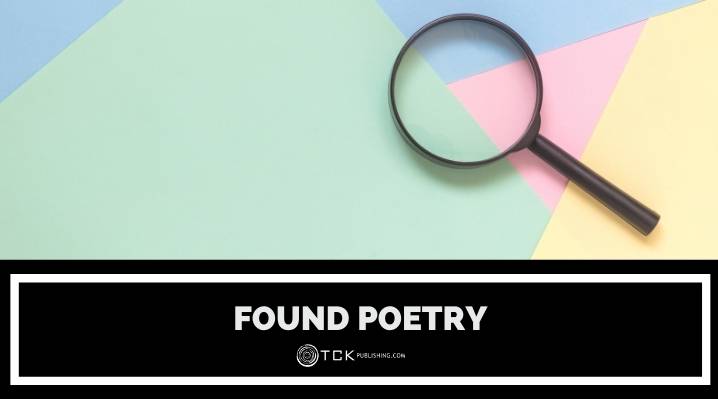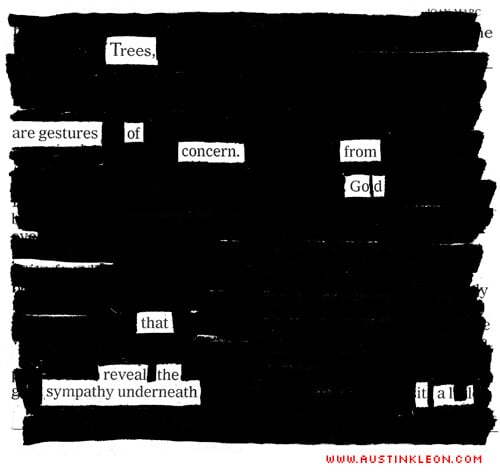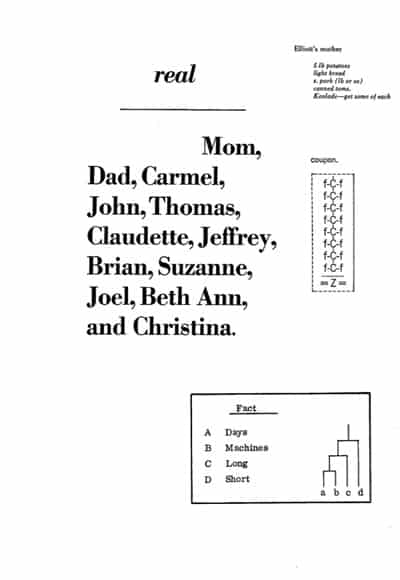
Poetry can be an intimidating subject for many of us. Since there are few rules when it comes to writing poetry, just getting started can be difficult.
But the good news is there’s a type of poetry that doesn’t require you to write any of the words yourself. “Found” poetry allows you to borrow words and phrases from other sources and reconstruct them to create new meanings.
In this post, we’ll show you examples of found poetry and offer you tips for creating your own found poem.
What Is Found Poetry?
Found poetry consists of text borrowed from different sources, such as articles, speeches, letters, street signs, and even other poems.
The “found” lines are then reassembled and fashioned in a way that creates a new poem or piece of art, kind of like a collage. In a new order and context, the recycled words take on new meaning.
How Do You Make a Found Poem?
Creating a found poem is pretty simple. All you have to do is find source material that inspires you.
While you can use pretty much any method to create a found poem, here are 3 of the most common types of found poetry you may want to try:
- Blackout poetry: You can create a blackout poem by taking a pen or marker and crossing out certain words or phrases from an existing poem. The remaining words create your new poem.
- Erasure poetry: Similar to blackout poems, erasure poems use whiteout to cover certain segments of text to create a new work from the remaining words.
- Cut-up poetry: This type most closely resembles a traditional collage, as you cut out words from magazines or different sources of text and arrange them to create new meaning.
Keep in mind that you can create a physical, printed found poem, or make one digitally by copying and pasting words, headlines, and other phrases together.
Examples of Found Poems
The following are examples of published found poems.
“Trees” by Austin Kleon
“Trees” is a blackout poem by New York Times bestselling author Austin Kleon, who published an entire book of blackout poems, Newspaper Blackout.

Testimony by Charles Reznikoff
In his book Testimony, American poet Charles Reznikoff created found poetry from law reports from 1885–1915.
The following is an excerpt:
Amelia was just fourteen and out of the orphan asylum;
at her first job—in the bindery, and yes sir, yes
ma’am, oh, so anxious to please.
She stood at the table, her blond hair hanging about
her shoulders, “knocking up” for Mary and Sadie,
the stichers (“knocking up” is counting books and
stacking them in piles to be taken away).
Found Poems by Bern Porter
American poet Bern Porter created multiple volumes of found poetry, including Found Poems, published in 1972.
Bern’s poems often used snippets of advertisements, scientific charts, product diagrams, newspaper articles, and other images to comment on consumerism and western culture.
Here’s an example:
What Is the Purpose of a Found Poem?
The purpose of creating a found poems is to reimagine existing words and repurpose them into something new.
Making a found poem challenges you to construct and extract new meanings from the original text, which is a great exercise in creativity and critical thinking.
Try Creating a Found Poem
Creating found poetry can be a very fun challenge! Why not get out some magazines, newspapers, or other material, and start cutting or blacking out words to create your own?
If you’re more of a visual learner, below is a video you can watch to see how the process of found poetry is done.
You can also check out more of the most common types of poetry to learn more about structure, rhyme scheme, and see examples of more traditional formats.
Did you find this post helpful? Let us know in the comments below!
If you enjoyed this post, then you might also like:
- 8 Lesser-Known Forms of Eastern Poetry
- Caesura: How to Vary Rhythm in Poetry
- 50 Poetry Prompts to Help Jumpstart Your Creativity
- 13 of the Best Poetry Apps: Fun Tools for Readers and Writers
As a blog writer for TCK Publishing, Kaelyn loves crafting fun and helpful content for writers, readers, and creative minds alike. She has a degree in International Affairs with a minor in Italian Studies, but her true passion has always been writing. Working remotely allows her to do even more of the things she loves, like traveling, cooking, and spending time with her family.

